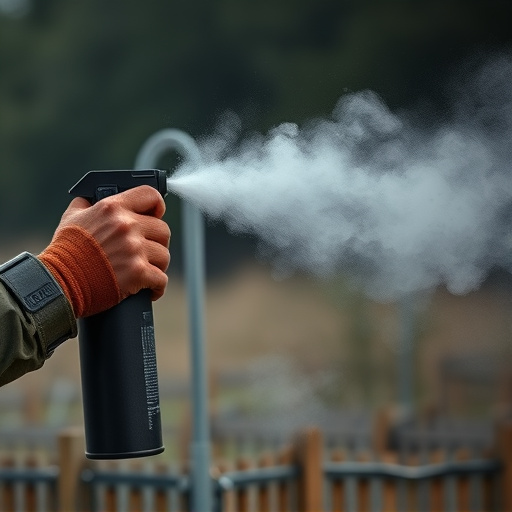In hot climates, effective pepper spray storage requires climate-controlled, secure vaults to protect against heat and humidity that accelerate capsaicin degradation. Best practices include regular inventory checks, access control, and proper disposal according to local hazardous waste regulations to maintain potency and safety.
In the realm of law enforcement, a police-grade inflammatory pepper spray compound is an indispensable tool. However, storing this potent substance in hot climates poses unique challenges due to its sensitivity to temperature fluctuations. This article delves into the science behind pepper spray’s active ingredients, explores factors affecting stability in hot climates, offers best practices for secure on-site storage solutions, and provides critical safety measures for handling and disposal techniques.
- Understanding Pepper Spray's Active Ingredients
- Factors Affecting Storage Stability in Hot Climates
- Best Practices for Secure On-Site Storage Solutions
- Safety Measures: Handling and Disposal Techniques
Understanding Pepper Spray's Active Ingredients
Pepper spray, a common tool employed by law enforcement agencies worldwide, contains a potent compound that disrupts normal bodily functions. The primary active ingredient is capsaicin, derived from chili peppers. This chemical irritates the eyes and respiratory system, leading to temporary incapacitation. Understanding this ingredient’s properties is crucial, especially in regions with hot climates where pepper spray storage and handling require special consideration.
Effective storage of pepper spray in such environments involves maintaining optimal conditions to preserve its potency. High temperatures can accelerate degradation, so secure, air-conditioned spaces are ideal. Additionally, proper labeling and regular maintenance ensure the spray remains safe and ready for use when needed.
Factors Affecting Storage Stability in Hot Climates
In hot climates, the storage stability of pepper spray becomes a critical consideration due to elevated temperatures. Several factors significantly impact its longevity and effectiveness in such environments. Firstly, heat is a catalyst for chemical degradation, accelerating the breakdown of active ingredients, particularly capsaicin, the key component responsible for the spicy sensation and inflammatory properties. As a result, hotter regions demand closer attention to storage conditions.
Furthermore, humidity levels play a crucial role. High moisture content in the air can lead to faster evaporation of the spray solution, potentially reducing its concentration over time. This is especially relevant when stored outdoors or in poorly ventilated areas. To mitigate these effects, manufacturers recommend specific storage guidelines, including keeping pepper spray compounds cool and dry, using airtight containers, and storing them in shaded areas to minimise direct sunlight exposure.
Best Practices for Secure On-Site Storage Solutions
In hot climates, where temperatures can skyrocket, proper storage of pepper spray becomes even more critical. To ensure effectiveness and safety, law enforcement agencies should implement best practices for on-site storage solutions. Secure, climate-controlled vaults are ideal for housing pepper spray compounds, protecting them from heat, humidity, and direct sunlight. These conditions can cause degradation and reduce the potency of the spray over time.
For added security, consider implementing access control measures like biometric scanners or keycard systems to restrict entry only to authorized personnel. Regular inventory checks and rotation of stock ensure that pepper spray remains in optimal condition and readily available when needed. By adopting these practices, agencies can guarantee the integrity of their chemical weapons and maintain high levels of operational readiness in challenging environmental conditions.
Safety Measures: Handling and Disposal Techniques
In handling police-grade inflammatory pepper spray, safety is paramount, especially in hot climates where such compounds can degrade more quickly. Proper storage techniques are crucial to maintaining potency and effectiveness. It’s recommended to store pepper spray in cool, dry, and dark places to prevent accelerated degradation. In areas with high heat and humidity, specialized cooling units or climate-controlled facilities may be necessary.
Disposal of used or expired pepper spray requires careful consideration. Local regulations dictate the appropriate methods, often involving specialized hazardous waste programs. Never dispose of it in regular trash or recycling bins. Users should stay informed about local guidelines to ensure safe handling and disposal practices, contributing to overall safety and environmental protection.
In conclusion, effective law enforcement relies on robust storage solutions for hot climate pepper spray. By understanding the active ingredients, recognizing factors that impact stability in warm environments, implementing secure storage practices, and adhering to safe handling and disposal techniques, agencies can ensure the integrity and readiness of their pepper spray inventory. Optimizing storage conditions and utilizing appropriate containers are key to maintaining performance, minimizing degradation, and maximizing officer safety during operations in challenging climates.
